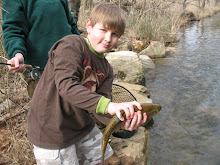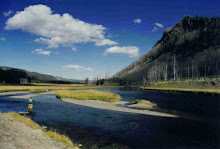

Much has been written about leaders and there are so many varieties of them out there that one barely knows where to start. Like other pieces of equipment, leaders get some attention but not as much as they should. The job they have to do is deliver the fly to its target. And that is a pretty important job or purpose. So why isn't more thought given to this? Who knows.
One of the most famous leader designs of all time was developed by George Harvey. Its as much a way of thinking on leaders as it is design. George Harvey understood the leader and its importance to the whole fly fishing game.
George Harvey was one of the true giants in Pennsylvania fly fishing history. Born in DuBois, Pennsylvania on November 14, 1911, George Harvey spent most of his life in Central Pennsylvania, teaching and writing about fly fishing. He graduated from Penn State University in 1935 with a Bachelor’s degree in Ornamental Horticulture. During his time at Penn State, he had the good fortune to meet and fish with Ralph Watts, Dean of the School of Agriculture. Dean Watts not only organized the first unofficial fly fishing class at Penn State, but recommended George Harvey for the position of instructor at the Mont Alto Forestry School, which is a part of Penn State. George Harvey moved to the main campus in 1942 and continued his angling classes, which because an officially credited class in 1947, called “Principles and Techniques of Fly Fishing and Fly Tying.” This was the first accredited college fly fishing class in America. He continued teaching the course until his retirement in 1972 and retired as an Associate Professor of Physical Education.
Folks usually get interested in and learn about the Harvey style leader when they begin fishing over selective trout and find that the technical nature of the fishing requires something more. Something that a leader on a fly shop wall just can't deliver. It will have you tying some of your own leaders. Use one and have success with it, you will use them from now on.
So what is a Harvey leader and why the big deal over it? First, a bit of background. A good many- - -well, most I should say - - -commercially available leaders are built on a 60 /20/20 taper. 60 percent butt, 20 percent taper, and 20 percent tippet. They carry lots of energy from the line to the leader and this pushes everything out nicely so that the fly goes to its target and the leader straightens out perfectly. That is fine for some fishing, like ponds, lakes, saltwater, etc, but if you are fishing over selective fish and fishing in current the last thing you want is a straight leader. Why? A straight leader causes drag....and a dragging fly the fish will ignore. George Harvey knew the real key was to design a leader with just enough butt to turn over the leader but that would not transfer so much energy or power that it would straighten the leader. He came up with several formulas, and its more of a style than a specific formula, but I have found them to be very effective for fishing over selective fish of our tailwater rivers like the Smith, Jackson, Watauga, Clinch, and South Holston.
Here are some formulas, a couple of them are from Gary Borger and his rendition of the Harvey Style leader.
Fly Size 10-16 : 4 feet of .016 Leader Material, 4 feet of .010 tippet, and 4 feet of 3, 4 or 5X
Fly Size 16-24 : 4 feet of .014 Leader Material, 4 feet of 3x tippet, 4 feet of 5,6, or 7X.
Illustration above is my variation with a fluorocarbon tippet of 6X.
Tie some of these up and give them a try..... Good fishing.





























